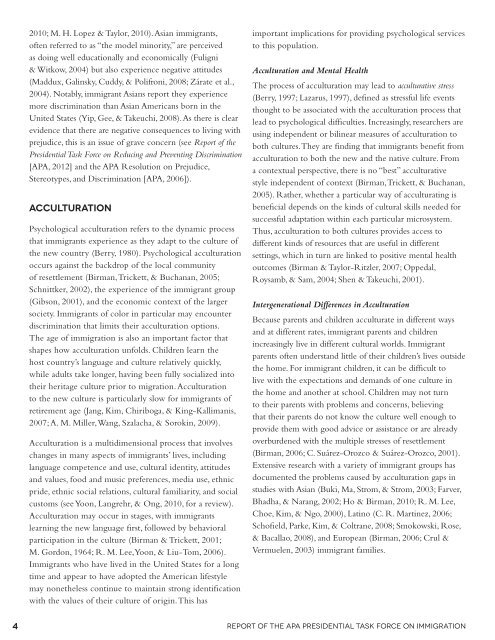Crossroads: The Psychology of Immigration in the New Century
Crossroads: The Psychology of Immigration in the New Century
Crossroads: The Psychology of Immigration in the New Century
Create successful ePaper yourself
Turn your PDF publications into a flip-book with our unique Google optimized e-Paper software.
2010; M. H. Lopez & Taylor, 2010). Asian immigrants,<br />
<strong>of</strong>ten referred to as “<strong>the</strong> model m<strong>in</strong>ority,” are perceived<br />
as do<strong>in</strong>g well educationally and economically (Fuligni<br />
& Witkow, 2004) but also experience negative attitudes<br />
(Maddux, Gal<strong>in</strong>sky, Cuddy, & Polifroni, 2008; Zárate et al.,<br />
2004). Notably, immigrant Asians report <strong>the</strong>y experience<br />
more discrim<strong>in</strong>ation than Asian Americans born <strong>in</strong> <strong>the</strong><br />
United States (Yip, Gee, & Takeuchi, 2008). As <strong>the</strong>re is clear<br />
evidence that <strong>the</strong>re are negative consequences to liv<strong>in</strong>g with<br />
prejudice, this is an issue <strong>of</strong> grave concern (see Report <strong>of</strong> <strong>the</strong><br />
Presidential Task Force on Reduc<strong>in</strong>g and Prevent<strong>in</strong>g Discrim<strong>in</strong>ation<br />
[APA, 2012] and <strong>the</strong> APA Resolution on Prejudice,<br />
Stereotypes, and Discrim<strong>in</strong>ation [APA, 2006]).<br />
acculturation<br />
Psychological acculturation refers to <strong>the</strong> dynamic process<br />
that immigrants experience as <strong>the</strong>y adapt to <strong>the</strong> culture <strong>of</strong><br />
<strong>the</strong> new country (Berry, 1980). Psychological acculturation<br />
occurs aga<strong>in</strong>st <strong>the</strong> backdrop <strong>of</strong> <strong>the</strong> local community<br />
<strong>of</strong> resettlement (Birman, Trickett, & Buchanan, 2005;<br />
Schnittker, 2002), <strong>the</strong> experience <strong>of</strong> <strong>the</strong> immigrant group<br />
(Gibson, 2001), and <strong>the</strong> economic context <strong>of</strong> <strong>the</strong> larger<br />
society. Immigrants <strong>of</strong> color <strong>in</strong> particular may encounter<br />
discrim<strong>in</strong>ation that limits <strong>the</strong>ir acculturation options.<br />
<strong>The</strong> age <strong>of</strong> immigration is also an important factor that<br />
shapes how acculturation unfolds. Children learn <strong>the</strong><br />
host country’s language and culture relatively quickly,<br />
while adults take longer, hav<strong>in</strong>g been fully socialized <strong>in</strong>to<br />
<strong>the</strong>ir heritage culture prior to migration. Acculturation<br />
to <strong>the</strong> new culture is particularly slow for immigrants <strong>of</strong><br />
retirement age (Jang, Kim, Chiriboga, & K<strong>in</strong>g-Kallimanis,<br />
2007; A. M. Miller, Wang, Szalacha, & Sorok<strong>in</strong>, 2009).<br />
Acculturation is a multidimensional process that <strong>in</strong>volves<br />
changes <strong>in</strong> many aspects <strong>of</strong> immigrants’ lives, <strong>in</strong>clud<strong>in</strong>g<br />
language competence and use, cultural identity, attitudes<br />
and values, food and music preferences, media use, ethnic<br />
pride, ethnic social relations, cultural familiarity, and social<br />
customs (see Yoon, Langrehr, & Ong, 2010, for a review).<br />
Acculturation may occur <strong>in</strong> stages, with immigrants<br />
learn<strong>in</strong>g <strong>the</strong> new language first, followed by behavioral<br />
participation <strong>in</strong> <strong>the</strong> culture (Birman & Trickett, 2001;<br />
M. Gordon, 1964; R. M. Lee, Yoon, & Liu-Tom, 2006).<br />
Immigrants who have lived <strong>in</strong> <strong>the</strong> United States for a long<br />
time and appear to have adopted <strong>the</strong> American lifestyle<br />
may none<strong>the</strong>less cont<strong>in</strong>ue to ma<strong>in</strong>ta<strong>in</strong> strong identification<br />
with <strong>the</strong> values <strong>of</strong> <strong>the</strong>ir culture <strong>of</strong> orig<strong>in</strong>. This has<br />
important implications for provid<strong>in</strong>g psychological services<br />
to this population.<br />
Acculturation and Mental Health<br />
<strong>The</strong> process <strong>of</strong> acculturation may lead to acculturative stress<br />
(Berry, 1997; Lazarus, 1997), def<strong>in</strong>ed as stressful life events<br />
thought to be associated with <strong>the</strong> acculturation process that<br />
lead to psychological difficulties. Increas<strong>in</strong>gly, researchers are<br />
us<strong>in</strong>g <strong>in</strong>dependent or bil<strong>in</strong>ear measures <strong>of</strong> acculturation to<br />
both cultures. <strong>The</strong>y are f<strong>in</strong>d<strong>in</strong>g that immigrants benefit from<br />
acculturation to both <strong>the</strong> new and <strong>the</strong> native culture. From<br />
a contextual perspective, <strong>the</strong>re is no “best” acculturative<br />
style <strong>in</strong>dependent <strong>of</strong> context (Birman, Trickett, & Buchanan,<br />
2005). Ra<strong>the</strong>r, whe<strong>the</strong>r a particular way <strong>of</strong> acculturat<strong>in</strong>g is<br />
beneficial depends on <strong>the</strong> k<strong>in</strong>ds <strong>of</strong> cultural skills needed for<br />
successful adaptation with<strong>in</strong> each particular microsystem.<br />
Thus, acculturation to both cultures provides access to<br />
different k<strong>in</strong>ds <strong>of</strong> resources that are useful <strong>in</strong> different<br />
sett<strong>in</strong>gs, which <strong>in</strong> turn are l<strong>in</strong>ked to positive mental health<br />
outcomes (Birman & Taylor-Ritzler, 2007; Oppedal,<br />
Roysamb, & Sam, 2004; Shen & Takeuchi, 2001).<br />
Intergenerational Differences <strong>in</strong> Acculturation<br />
Because parents and children acculturate <strong>in</strong> different ways<br />
and at different rates, immigrant parents and children<br />
<strong>in</strong>creas<strong>in</strong>gly live <strong>in</strong> different cultural worlds. Immigrant<br />
parents <strong>of</strong>ten understand little <strong>of</strong> <strong>the</strong>ir children’s lives outside<br />
<strong>the</strong> home. For immigrant children, it can be difficult to<br />
live with <strong>the</strong> expectations and demands <strong>of</strong> one culture <strong>in</strong><br />
<strong>the</strong> home and ano<strong>the</strong>r at school. Children may not turn<br />
to <strong>the</strong>ir parents with problems and concerns, believ<strong>in</strong>g<br />
that <strong>the</strong>ir parents do not know <strong>the</strong> culture well enough to<br />
provide <strong>the</strong>m with good advice or assistance or are already<br />
overburdened with <strong>the</strong> multiple stresses <strong>of</strong> resettlement<br />
(Birman, 2006; C. Suárez-Orozco & Suárez-Orozco, 2001).<br />
Extensive research with a variety <strong>of</strong> immigrant groups has<br />
documented <strong>the</strong> problems caused by acculturation gaps <strong>in</strong><br />
studies with Asian (Buki, Ma, Strom, & Strom, 2003; Farver,<br />
Bhadha, & Narang, 2002; Ho & Birman, 2010; R. M. Lee,<br />
Choe, Kim, & Ngo, 2000), Lat<strong>in</strong>o (C. R. Mart<strong>in</strong>ez, 2006;<br />
Sch<strong>of</strong>ield, Parke, Kim, & Coltrane, 2008; Smokowski, Rose,<br />
& Bacallao, 2008), and European (Birman, 2006; Crul &<br />
Vermuelen, 2003) immigrant families.<br />
4 Report <strong>of</strong> <strong>the</strong> APA Presidential Task Force on <strong>Immigration</strong>
















